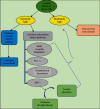Role of RONS and eIFs in Cancer Progression
- PMID: 34285764
- PMCID: PMC8275427
- DOI: 10.1155/2021/5522054
Role of RONS and eIFs in Cancer Progression
Abstract
Various research works have piled up conflicting evidence questioning the effect of oxidative stress in cancer. Reactive oxygen and nitrogen species (RONS) are the reactive radicals and nonradical derivatives of oxygen and nitrogen. RONS can act as a double-edged weapon. On the one hand, RONS can promote cancer initiation through activating certain signal transduction pathways that direct proliferation, survival, and stress resistance. On the other hand, they can mitigate cancer progression via their resultant oxidative stress that causes many cancer cells to die, as some recent studies have proposed that high RONS levels can limit the survival of cancer cells during certain phases of cancer development. Similarly, eukaryotic translation initiation factors are key players in the process of cellular transformation and tumorigenesis. Dysregulation of such translation initiation factors in the form of overexpression, downregulation, or phosphorylation is associated with cancer cell's altering capability of survival, metastasis, and angiogenesis. Nonetheless, eIFs can affect tumor age-related features. Data shows that alternating the eukaryotic translation initiation apparatus can impact many downstream cellular signaling pathways that directly affect cancer development. Hence, researchers have been conducting various experiments towards a new trajectory to find novel therapeutic molecular targets to improve the efficacy of anticancer drugs as well as reduce their side effects, with a special focus on oxidative stress and initiation of translation to harness their effect in cancer development. An increasing body of scientific evidence recently links oxidative stress and translation initiation factors to cancer-related signaling pathways. Therefore, in this review, we present and summarize the recent findings in this field linking certain signaling pathways related to tumorigeneses such as MAPK and PI3K, with either RONS or eIFs.
Copyright © 2021 Yasmeen Ahmed Salaheldin et al.
Conflict of interest statement
The authors declare that they have no competing interests.
Figures


References
Publication types
MeSH terms
Substances
LinkOut - more resources
Full Text Sources
Medical

